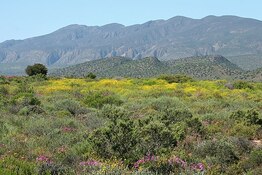
In ecological news, prescribed burns, which benefit many species and reduce wildfire threats, also spread a weed named stinknet. https://www.sciencedaily.com/releases/2023/05/230523123834.htm Stinknet provides a lovely, recently well-recognized wildflower across the Southwestern United States, especially in California and the Sonoran Desert bioregion. Stinknet first appeared in Tucson in 2015, and since has consumed most of that area. Stinknet is known to cause rashes and headaches, and is especially likely to stimulate asthma attacks. See also this recent news segment: https://www.kold.com/2023/04/05/do-you-have-this-weed-your-yard-experts-say-stinknet-is-causing-major-problems/
Stinknet was imported to the Phoenix area as a cultured desert habitat specimen, and spread to California via fill material and farming equipment. A major challenge with stinknet is that it crowds out native plants. So, what ought we do with invasive species? Experts are suggesting herbicides, aminopyralid, triclopyr, and glyphosate to control the plant before it has flowered. Among rats, aminopyralid can cause chronic toxicity, effects including enlargement of the intestines and mucous membranes. Dangers of triclopyr include acute toxicity if individuals eat, touch, or inhale residues. Breathing in glyphosate can cause eye and skin irritation. Swallowing it may increase saliva, cause burns in the mouth and throat, nausea, vomiting, and diarrhea. If, even if in large doses, these herbicides cause negative among humans, it is hard to know all of the ecological consequences, including dangers to specific species living in those ecosystems. For instance, glyphosate predisposes plants to diseases and modify soil microflora. Triclopyr can cause microbial degradation, and is slightly toxic to birds. And in 2020, Aminopyralid’s risks were assessed, which led to increased regulated use of this pesticide. https://www.regulations.gov/document/EPA-HQ-OPP-2013-0749-0048
Ultimately, like many invasives, we may have to learn to live with stinknet, whether after years of using it as an excuse to further poison our ecosystems, or without the poisonous middle-step we’ve taken for invasive flora and fauna over the last century. What is your opinion? How do you address invasive species through music in your classrooms?
DS
Image link: https://upload.wikimedia.org/wikipedia/commons/thumb/f/f7/Oncosiphon_pilulifer_20D_2701.jpg/640px-Oncosiphon_pilulifer_20D_2701.jpg
 RSS Feed
RSS Feed
